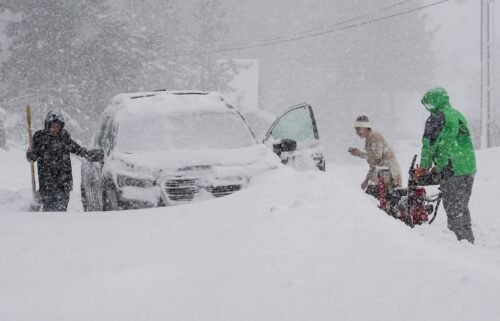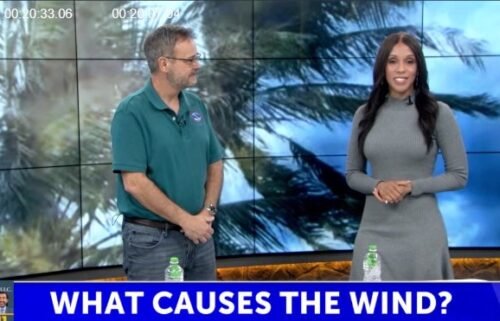The flooding in New York left weather experts with a dreadful feeling in the pit of their stomachs
By Jennifer Gray and Haley Brink, CNN Meteorologists
As meteorologists, we are still stunned by what happened in the Northeast last week. The flooding was forecast, but to see New York City underwater was not something anyone could have imagined.
“As you see it unfold, you’re just gripped with this growing pit in your stomach when you look at this data on your screen and it keeps adding up to something very bad happening,” said Alex Lamers, meteorologist at the Weather Prediction Center.
As the world watched what occurred in the Northeast due to the remnants of Hurricane Ida, jaws dropped as the stunning images started to emerge.
It wasn’t because the forecast was a bust. In fact, the forecast was spot-on. Three days in advance, the prediction center was watching the potential for major flooding. It labeled last Wednesday as a “high risk” day for extreme rainfall. That only happens about 4% of the time, so these days are taken seriously in the weather community.
Lamers was at the prediction center that day, watching it go down in real time. So, I (Jennifer Gray) decided to call him and get his thoughts on what happened that day.
“Over the course of the day there was just a growing concern. As things started coming together and seeing how the storm would likely track and the possibility that this would move right up the interstate into (New York City), and that’s what happened,” said Lamers.
While the rainfalls totals were staggering, what was even more stunning was how fast the rain came down.
“The fact you had those extreme rain rates that aligned over that densely populated area is why it unfolded the way it did,” said Lamers.
So much rain in such a short amount of time is what ultimately led to the catastrophe.
It’s one thing to have an inch of rain fall over the course of the day; it’s another to have that inch fall in 10 minutes. Forecasting exactly where the heaviest bands of rain will occur is impossible until a few hours before, and to see them set up over such a populated city as New York City was shocking.
“I think the thing that stands out to me are the heaviest rain rates were lined up perfectly with one of the most densely populated cities in the country. Twenty to 30 miles can make a huge difference. JFK had less than 3 inches, while Newark had over 9,” Lamers said, referring to two major airports.
Near Elizabeth, New Jersey, more than 10 inches of rain was reported. More than three 3 of rain fell in Central Park in just one hour.
“There were exceptional rain rates. There was an observation in the Bronx with 4 inches of rain in an hour. Four inches of rain in an hour is going to cause problems in most places. Of course, it will have a much bigger impact in an area that’s paved with a lot of concrete than sandy soils,” said Lamers.
And we saw the outcome. Streets and homes flooded, people got trapped in their cars. Major interstates flooded nearly to the overpasses above.
Subways had water rushing in, and people had to be rescued from their rooftops. And the nightmare didn’t stop with the rain. Over a dozen tornadoes were also reported across many of these same areas. At least 46 people died in Ida’s second punch that impacted the East.
It was a devastating day, caused by a storm that unleashed damage and heartbreak from the Gulf Coast to the Northeast. Ida’s path spanned 1,500 miles.
It’s something that could become a new normal, with climate change.
“If you look at the recent (Intergovernmental Panel on Climate Change) report and the most recent climate report, both of those have concluded that there have been observable increases with the intensity and frequency of intense rainfall events. This increase is expected to continue in a warming world. Because of the basic principle that warmer air on average can hold more water vapor,” said Lamers.
Lamers encourages people to be ready if there’s ever another “high risk” day. Plan ahead just as you would if your area was issued a tornado watch. Be alert.
Try not to get on the roads unless absolutely necessary. He says 2 out of every 3 people who die in flooding die in their cars. And of course, never drive through flooded waters.
“I think we are going to be dealing with extreme rainfall events for the foreseeable future, and we are going to do our best to equip people the best we can to make decisions when there’s an extreme rain event on the horizon,” said Lamers.
In pictures: Ida’s remnants thrash the Northeast
More flooding and extreme heat impact those hit by Ida
Residents along the Gulf Coast will continue cleanup this week after the devastation left by Ida. Unfortunately, more rain and extreme heat is in the forecast this week.
More than 2 million people are under flash flood watches, as slow-moving storms could bring 2 to 3 inches of rain in a short amount of time. This includes in New Orleans, as well as some of the hardest hit areas such as Houma and LaPlace.
The heat will also be an issue this week across the hard-hit Gulf Coast, where a heat advisory is in place for nearly 3 million people.
More than half a million people still have no power, and many of those people are under this heat advisory. Heat index values could reach as high as 100 to 105 on Monday.
The National Weather Service is encouraging residents to “take extra precautions if you work or spend time outside. When possible reschedule strenuous activities to early morning or evening.” In fact, the weather service lowered the threshold for a heat advisory because so many people are without power.
While cleanup is ongoing, many people could find themselves overexerting — then not having a cool place to cool down.
It’s important to try to not get too hot or to find a cooling center nearby to find relief. Heat causes the most weather-related fatalities on average, according to the weather service.
More on Ida:
- Residents of hard-hit Louisiana town undeterred by another deadly hurricane
- In pictures: Hurricane Ida devastates Gulf Coast
- Before-and-after aerial images show devastation left by Ida in Louisiana
Peak of hurricane season
This week marks the peak of Atlantic hurricane season, and the tropics are active, with Hurricane Larry churning in the middle of the Atlantic and a tropical disturbance in the Gulf of Mexico.
Let’s begin with Larry. In case you missed it, Larry developed early last week, becoming a tropical storm on Wednesday and a hurricane the following day.
Hurricane Larry then rapidly intensified — when a storm gains 30 mph in wind speed in 24 hours or less — into a major Category 3 hurricane Thursday night into Friday. This made Larry the third major hurricane of the season, following Grace and Ida.
Today, Larry maintains its Category 3, major hurricane status as it tracks through the open waters of the Atlantic.
Fortunately, Larry is not forecast to make landfall, however it is generating large swells that are impacting the Lesser Antilles, the Bahamas and Bermuda.
These significant swells are expected to impact the East Coast of the US and Atlantic Canada by the middle of the week. “These swells will likely cause life-threatening surf and rip current conditions,” the National Hurricane Center said on Monday.
Bermuda may want to keep a close eye on Larry this week. The current forecast track has the hurricane tracking to the east of the island by Thursday, bringing with it the threat of strong winds, heavy rain and coastal flooding.
“While it is too soon to determine the magnitude of these hazards and potential impacts on Bermuda, interests there should closely monitor the latest forecast updates during the next several days,” the hurricane center said on Monday.
We are also monitoring a tropical disturbance in the Gulf of Mexico. This area of showers and thunderstorms is forecast to remain disorganized as it tracks across the Gulf towards Florida.
This disturbance is expected to track across the Southeast US by midweek, increasing showers and storms across northern Florida and southern Georgia.
Some development will be possible once this area of storms tracks into the Atlantic later this week. Portions of the coastal Carolinas may want to keep an eye on these storms late this week and into the weekend.
Firefighters in the West gain ground, yet new fires emerge
While some of the biggest fires in the West slowed down, several new fires have ignited. Evacuation orders for South Lake Tahoe were downgraded after some progress was made with containing the Caldor Fire.
The Caldor fire has consumed over 216,000 acres near the California-Nevada border, according to Cal Fire. The fire has been burning since August 14, and now it’s is 44% contained.
The Caldor Fire has destroyed more than 900 structures since it began, with more than 27,000 structures still threatened.
In Amador County, near where the Caldor Fire is burning, the Lawrence Fire spread to 40 acres, burning grass, brush and timber, Cal Fire said.
The fire prompted brief road closures and evacuations as it threatened a handful of structures, but firefighters quickly mitigated the threat. The Lawrence Fire was 30% contained Sunday evening.
Farther north in Placer County, the Bridge Fire burned 250 acres with 0% containment as of Sunday evening. Evacuations are in progress, Cal Fire noted.
In Southern California, the Aruba Fire sparked in San Diego County, burning 100 acres southeast of the community of Rainbow, Cal Fire said. It was 15% contained Sunday night.
“Nearly 25 million in California, Nevada and Arizona will experience temperatures up to 20 degrees above average, meaning the region could see 105 to 115 degrees,” CNN meteorologist Michael Guy said. “The majority of the heat will impact the desert Southwest.”
There’s also a red flag warning in effect Tuesday for portions of central Oregon and central Northern California, meaning conditions will be optimal for fire to spread.
Ending on a high note
We wanted to end this week’s weather column on a positive note. Watch as this meteorologist’s dog interrupts his weather report. This cute fur ball is aptly named Storm.
The-CNN-Wire
™ & © 2021 Cable News Network, Inc., a WarnerMedia Company. All rights reserved.
CNN’s Kelly McCleary and Alta Spells contributed to this report.




